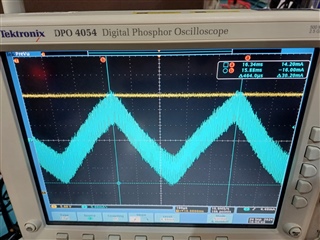Other Parts Discussed in Thread: TPS923655
Tool/software:
Using the EVM module to drive a string of LEDs. Vin = 24V. Vout = ~36V. Iout = 100mA - 500mA. PWM pin high. ADIM pin running a fixed 1Khz PWM sequence, set to give a fixed current.
I can see approx 5mA ripple current through the LEDs caused by the DC converter switching frequency, but there is a larger ~30mA p-p,~2.2KHz triangular current on top of this. The EVM has a TPS923655 fitted which includes spread spectrum. Is the spread spectrum feature causing this larger 30mA p-p triangular ripple? I have tried with different sources of the ADIM pwm signals so I don't believe that it is caused by the inputs. A larger output current produces a large triangular ripple.


